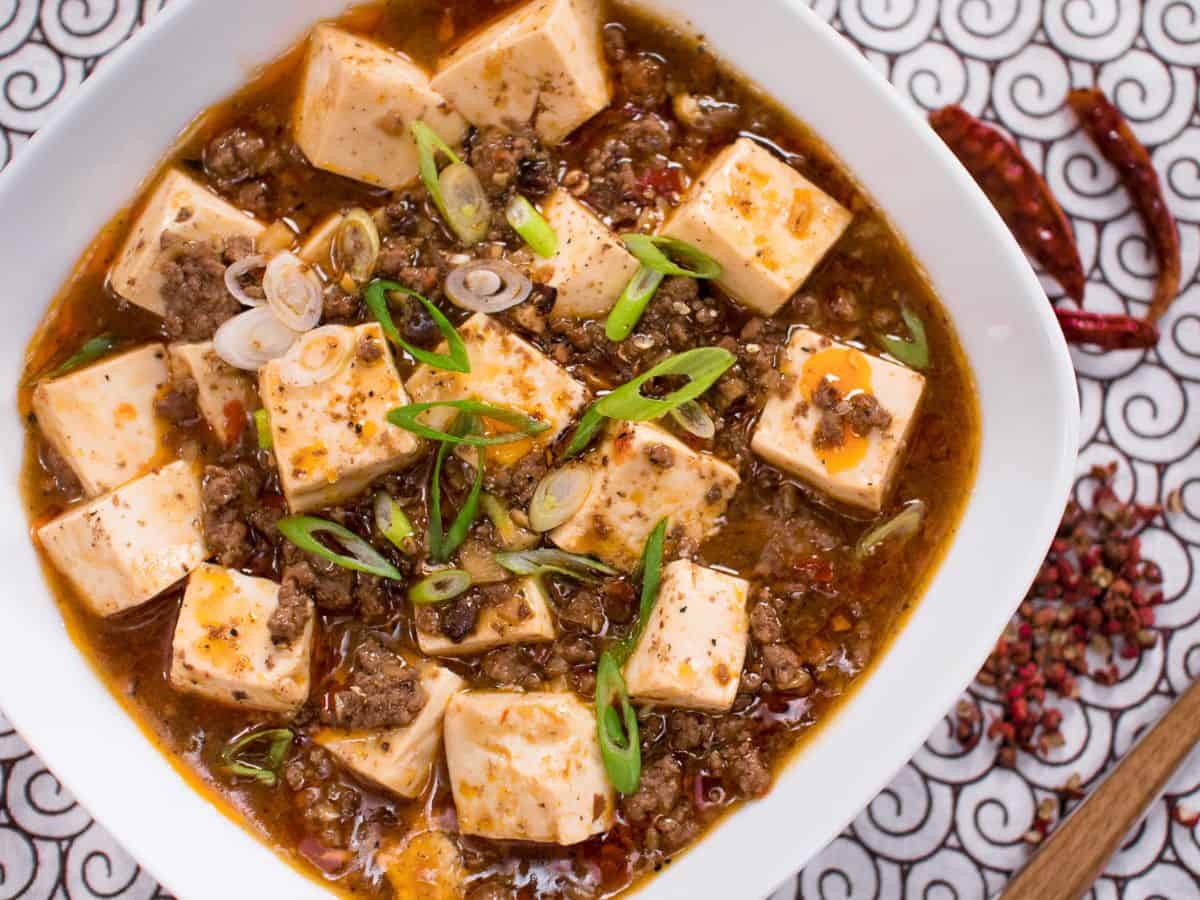Mapo tofu is easily my favourite Chinese recipe. Soft, silky tofu in a rich, spicy, flavourful meat sauce...it's always a crowd pleaser. There are a few ingredients to get to know if you haven't had much experience with Chinese cooking, but the process is really straight forward and can be a relatively quick dinner. It also keeps well, so make lots and have extra for lunch the next day!
Watch the Video Tutorial for This Recipe

Want to save this recipe?
What is Mapo Tofu?
Mapo tofu is an iconic dish of Sichuan cuisine, Sichuan being the southwestern province of China, known for its flavourful, spicy food. Mapo tofu combines two seemingly opposite components - silky, mild tofu and a spicy meat sauce - and they balance each other out in the most spectacular way.
I particularly love mapo tofu because it exemplifies a fact I've been trying to preach to the Western audience: tofu is not merely a meat substitute or just for vegetarian cooking, but an ingredient that is as versatile as any, and has a place in a meat-based dishes as well.
Ingredients
Mapo tofu uses a few ingredients that might be new to you if you've never done any Sichuan cooking before, but no worries, I've got you covered with all the info!
- Sichuan peppercorns, toasted. (See note below)
- Ground beef
- Soy sauce
- Garlic
- Ginger
- Black pepper
- Spicy broad bean paste or douban jiang or toban djan (see note below)
- Chinese black beans or douchi
- Unsalted chicken stock, pork stock, or water
- Chinese cooking wine (optional)
- Sugar
- Cornstarch
- Medium smooth tofu or soft tofu
- Green onions
- Chili oil (optional for garnish)
Sichuan peppercorns
You can buy Sichuan peppercorns at Chinese grocery stores. They come in green and red varieties, either will work and have similar aroma, but I prefer red personally. These peppercorns give a unique aroma and also a tongue-numbing sensation. Some people like a little numbness, others like a lot. To be safe, the amount I provided for this recipe is quite mild, so feel free to add more if you like a lot of numbness!

Spicy broad bean paste - Doubanjiang
Also called "toban djan," this is an important ingredient in mapo tofu, but it is usually available at Chinese grocery stores. Lee Kum Kee is the only brand available at my store, but try googling some images of other brands as well in case the ones you have at your store look different!

Chinese black beans:
This is the stuff "black bean sauce" is made of. But they are not actually black beans! These are salty fermented soybeans that turned black in the process. They are commonly available at any Chinese grocery stores in small bags or in bigger tubs. I always give these a rinse first before using to wash off excess salt. Once you have them, you must try this amazing steamed fish with black bean sauce recipe!

Choosing the right tofu:
You want your tofu smooth and silky, but not so soft that it will fall apart in the dish. So I don't generally go with soft or silken tofu as they're a bit too delicate, but you absolutely can if you can be gentle with it.
The one I use is referred to as "smooth tofu" but you can also get one that's labeled "traditional tofu". There is no firmness designation on this kind of tofu because for Chinese people it's sort of the the "regular" tofu if you will. It is slightly softer than "medium" tofu but firmer than "soft." If not available, soft of medium firm are fine.
Mapo Tofu Step-By-Step Instructions

- Add the beef and soy sauce in a hot wok without any added oil and cook, breaking it up into small pieces.
- Once the beef is browned, remove from the pan.
- Add a little more cooking oil to the pan and saute the garlic and ginger for a few minutes until soft and aromatic.
- Add ground black pepper, half of the ground Sichuan peppercorns, the broad bean paste and the black beans. Saute for about 30 seconds

- Deglaze with stock, scraping off any bits that are stuck to the bottom. Add the sugar, Chinese cooking wine, and the beef.
- Simmer gently for 5 mins to reduce and to allow flavours to mingle.
- Dissolve the cornstarch in some water and stir it into the sauce, a little at a time until desired consistency.
- Gently add the tofu and nudge it around so it is sitting in one layer. Spoon some the sauce over the tofu, then let it simmer gently for another 5 minutes, and you're done! Serve with rice and garnish with chopped green onions and chili oil, if desired.
Recipe Tips
- Actually BROWN the beef. When recipes call for browning ground beef, many people take than to mean just "cook" the beef. If you just cook it until it's cooked, your beef will just taste like...steamed beef. But if you take the time to let the beef actually develop browning, like the crust on a steak, you will be rewarded with robust, beefy flavours that really make a difference.
- Don't overdo Sichuan peppercorns. If you've not experienced the tongue numbing effect of Sichuan peppercorns before, start slow as it might feel a little disconcerting at first, and some people don't like it. Put half of it into the dish, and keep the other half on the side and you and add it in after if you decide you like the sensation.
FAQ
It can be as spicy as you want! If you make the recipe as is, it will be very mild, and the doubanjiang isn't very hot at all (speaking as a Thai person here). This is why I offer chili oil as a way to boost the heat if you prefer it spicier.
If you don't eat beef, you can make mapo tofu with lamb or pork. A chicken version works too, but be sure to use dark meat chicken only.
You can make the sauce in advance, and on serving day, reheat the sauce with the tofu. The sauce will keep in the fridge for up to a week. Leftovers will also keep in the fridge for up to a week, and it'll probably taste even better! Reheat in the microwave.
Watch The Full Video Tutorial!
All my recipes come with step-by-step video tutorials with extra tips not mentioned in the blog post, so make sure you watch the video below to ensure success - and if you enjoy the show, please consider subscribing to my YouTube channel. Thank you!

Mapo Tofu
- Prep Time: 30 mins
- Cook Time: 15 mins
- Total Time: 45 minutes
- Yield: Serves 4
Ingredients
Want to save this recipe?
- 1 ½ tsp Sichuan peppercorns, toasted (see note)
- 200g ground beef
- 2 tsp soy sauce
- 5 cloves garlic, finely chopped
- 2-inch piece ginger, finely chopped
- ½ tsp ground black pepper
- 2 Tbsp spicy broad bean paste (see note)
- 1 Tbsp Chinese black beans, rinsed and roughly chopped (see note)
- 1 cup chicken stock or pork stock, UNSALTED, or water
- 2 Tbsp Chinese cooking wine (optional)
- 1 ½ tsp sugar
- 1 Tbsp cornstarch
- 350g smooth soft tofu, 1-inch cubes (see note)
- 1 Green onions, chopped
- Chili oil (optional, see note)
- Jasmine rice for serving
Instructions
Toast Sichuan peppercorns in a dry saute pan for a few minutes, stirring constantly until they are aromatic and darken slightly. Grind in a mortar and pestle or a coffee grinder until fine.
Heat a wok or a saute pan over medium high heat, add the ground beef (no oil needed) and the soy sauce. Cook the beef, stirring constantly to break it up into small pieces, until the water that comes out of the meat has evaporated and the beef is browned slightly.
Turn off the heat and remove the beef with a slotted spoon, leaving any fat behind. If your beef is quite lean and there isn't much fat left, add a little more cooking oil to the pan so there's enough to saute the garlic and ginger.
Turn the heat back on to medium, add garlic and ginger and saute until the garlic starts to turn golden. Add ground black pepper, half of the ground Sichuan peppercorns (or all of it if you like more of the numbness and aroma), the broad bean paste and the black beans. Saute the herbs and seasoning for about 30 seconds, then deglaze with stock, scraping off any bits that are stuck to the bottom.
Add sugar, Chinese cooking wine, and the beef; simmer gently for 5 mins.
Meanwhile, dissolve the cornstarch in about 3 tablespoon of cold water.
When the sauce is done simmering, pour in half of the cornstarch slurry while stirring, and let it come back to a simmer. Check the sauce for thickness, and if it's still too runny, add a little bit more of the cornstarch slurry until the desired consistency is reached. Taste and adjust seasoning as needed.
Add the tofu to the sauce and gently nudge the tofu around so it is sitting in one layer. Spoon some the sauce over the tofu, then let it simmer gently for another 5 minutes.
Transfer onto a serving bowl, drizzle with more chili oil if desired, and garnish with chopped green onions and some of the reserved Sichuan peppercorns if desired. Tip: Some people do not like the numbing sensation from the Sichuan peppercorns, so it might be safe to serve the extra Sichuan pepper on the side so people can sprinkle on more if they want it.
Serve with jasmine rice, and enjoy!
Notes
- Sichuan peppercorns: They come in green and red varieties, either will work, but I prefer red. These peppercorns give a unique aroma and a tongue-numbing sensation which some people don't love. So to be safe, the amount I provided for this recipe is quite mild, so feel free to add more if you like a lot of numbness!
- Spicy broad bean paste: Called "douban jiang" or "toban djan," the brand I use is Lee Kum Kee, and is commonly available at Chinese grocers.
- Chinese black beans: These are actually fermented soybeans and are widely available; they come in small bags or in bigger tubs.
- Choosing the right tofu: You want it smooth and soft, but not so soft that it will fall apart in the dish. What I use is labelled "smooth tofu" or "traditional tofu" which is somewhere between soft and medium. Either soft or medium firm tofu can be used instead, but be very gentle is using soft.
- Chili oil: You can buy chili oil but it is also very easy to make. Take any kind of spicy dried chilies and grind it into a powder. Add the chilies into a small pot and add neutral oil at a ratio of about 1 tablespoon chili powder to ¼ cup oil. Gently heat the oil over medium-low heat, stirring frequently, until the chilies turn a little darker and smell smoky. Keep in the fridge to prevent it from going rancid.





Tee says
Is there a Thai version of Mapo Tofu using ingredients found in Thai cuisine? I know there are Korean and Japanese versions of this dish.
Pailin Chongchitnant says
We do make a tofu-in-ground-pork-sauce type of dish, but it tastes so different I wouldn't call it a version of mapo tofu.
Jens (Der Reiskoch) says
Do you have a recipe or at least a Thai name for this "tofu-in-ground-pork-sauce type of dish" ?
Thank you in advance!
Hollis Ramsey says
I love that your recipe includes douchi. I know that beef is traditional, but I prefer pork — it is not a sin to do so. I also don't mind if the tofu breaks up. This is a very good recipe. Thank you.